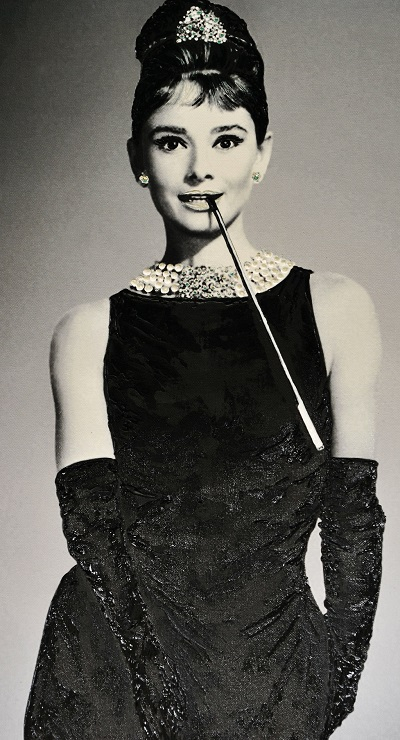

In the 1920s, when the idea of the “little black dress” first appeared, it was inspired by Coco Chanel.  For Breakfast at Tiffany’s and its long-time subject, Hubert de Givenchy created a sheath dress with basic slashes on the back based on this timeless example of undeniable elegance. Former Givenchy design director Riccardo Tisci described the garment as the epitome of 1960s fashion: stylish up front, delicate, sensual, and Parisian in back.
For Breakfast at Tiffany’s and its long-time subject, Hubert de Givenchy created a sheath dress with basic slashes on the back based on this timeless example of undeniable elegance. Former Givenchy design director Riccardo Tisci described the garment as the epitome of 1960s fashion: stylish up front, delicate, sensual, and Parisian in back.
Even though our morning attire is not as unusual as Holly Golightly’s, this iconic robe leaves us with the impression that the “little black dress” will always be in style. Later in the movie, another garment, also by Hubert de Givenchy, was seen. Audrey Hepburn wore a sleeveless black gown, a wide-brimmed hat, and black opera gloves. It was made of wrinkled silk.
Blake Edwards’ 1961 film “Breakfast at Tiffany’s,” which was based on the Truman Capote novella, featured Audrey Hepburn as disturbed call girl Holly Golightly. She first appears in the movie’s opening scene, slipping out of a yellow cab in front of the upscale diamond store Tiffany’s on a deserted Fifth Avenue in New York City before dawn. She wears a slinky black satin dress, long satin gloves, big tortoiseshell sunglasses, pearl strands around her neck, and a diamond hair adornment. She enjoys a cup of coffee while munching on a doughnut and looking into the jewellery store’s window. She defined one of fashion’s most recognisable pieces in a single scene: the little black dress (aka LBD).
The little black dress was created by Hubert de Givenchy, the founder of the Givenchy fashion house in Paris. Givenchy and Hepburn have worked together in the past and held a great deal of respect for one another. When Hepburn suggested meeting with a genuine French designer while working on the movie Sabrina in 1953, the two got acquainted. In order to get another dazzling appearance, Hepburn turned to Givenchy when she was chosen to play the lead in Breakfast at Tiffany’s. And she did get it, but it didn’t work out the first time. Givenchy originally intended to create a shorter version of the dress, but Paramount Pictures executives thought it was too “revealing” of the actress’s legs. The beautiful full-length number seen in the movie was created when they asked Paramount costume designer Edith Head to redesign the lower half.
The outfit is reminiscent of Coco Chanel, who invented the “little black dress” in the 1920s. The dress itself has no sleeves and a neckline that emphasises Hepburn’s shoulders. The thigh-high slit and “demi-lune” cutouts at the rear give the outfit a seductive edge. It would be lovely on its own, but when enhanced with some tasteful embellishments, it became legendary. Hepburn completes the ensemble in the movie with a chunky pearl necklace, matching black gloves, and a tiara worn in her stylish updo.
Hepburn’s Holly can be seen enjoying the jewellery on display in the Tiffany & Co. window while munching on a Danish and sipping coffee in the opening scene of the movie. Both film and fashion experts have applauded the way Holly’s character is enhanced and developed as soon as she wears the garment. The Washington Post notes that, despite the fact that it is morning and breakfast time, this dress is obviously meant for an evening party. Her elegance and her lack of destruction imply that she has been out all night but doesn’t appear destroyed. Actually, she looks fantastic.
In fact, it was so magnificent that it contributed to the “little black dress” being one of the fundamental outfits every woman ought to own. It frequently appears in film montages and is a popular Halloween costume. Even in the twenty-first century, it made a comeback when Natalie Portman wore it for a Harper’s Bazaar cover photoshoot in 2006. Later that year, in 2006, the garment fetched a staggering 467,200 British pounds when it was auctioned off (more than 600,000 U.S. dollars). Between GBP 50,000 and GBP 70,000 were estimated. Givenchy personally donated the outfit since the money from the auction would be used to construct a school in Calcutta.
The buyer was an “anonymous telephone buyer,” so it’s actually a mystery who the dress’s present owner is. The outfit will live on among fans of both movies and fashion, regardless of who it formerly belonged to. Next, be sure to peruse this list of movies to watch for exquisite attire.
To conclude, the “little black dress” Holly Golightly wears in Breakfast at Tiffany’s is perhaps more famous than the film itself because even people who haven’t seen it may recognise the image of Audrey Hepburn wearing it. It’s actually sort of amazing how straightforward the dress is for one of the most well-known movie costumes—and dresses, period—of all time. But that was part of the allure of it, and it’s obvious that the dress’s simplicity was a plus, as it gave rise to the “little black dress” trend that is still popular today.